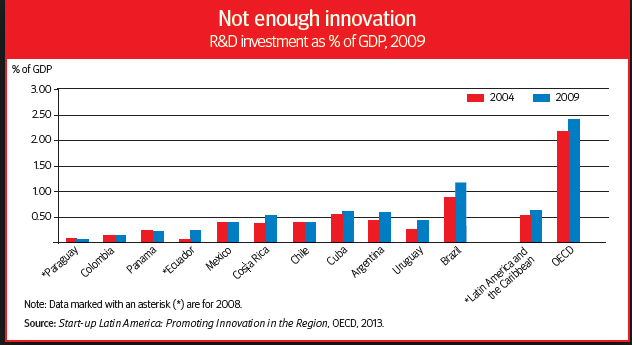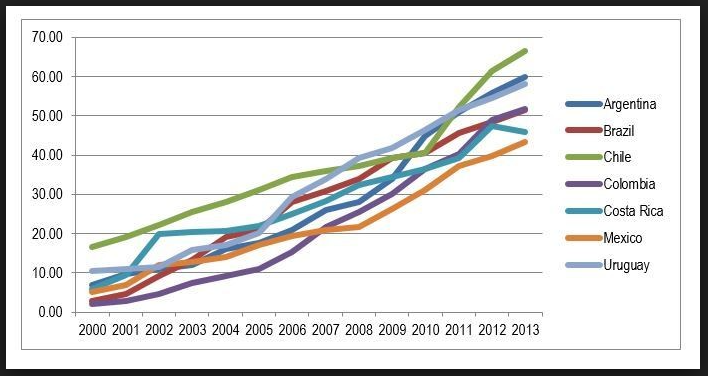Study Bay Coursework Assignment Writing Help
Globalization of Technology in Latin America
Introduction
Globalisation and know-how have influenced each half of human life, in nearly each nation in the world from the economic system to socialisation and communication. We use know-how in our day-to-day life, from cooking and converse with kinfolk/ associates in one other half of the globe and so for that maintain folks in contact. Furthermore, in this context, I made a decision to discover how is the know-how been working in Latin America international locations, to see if they’re developed and been coped with different developed international locations as a result of, with out know-how, as we speak’s society would wrestle with the each day bases mundane of issues.
The web has revolutionised the way in which the organisation communicates, outlets and trades. The web has turn into a necessity in developed international locations. Nevertheless, some States have adopted this new know-how quicker than others have. This essay seems on the evolution of know-how, and the doable the explanation why it has might be behind when in comparison with different international locations economic system, welfare states in addition to different causes.
Globalization of know-how in Latin America
Latin America it’s composed by 20 international locations which they’re Argentina, Bolivia, Brazil, Chile, Colombia, Costa Rica, Cuba, Ecuador, El Salvador, Guatemala, Haiti, Honduras, Mexico, Nicaragua, Panama, Paraguay, Peru, Dominican Republic, Uruguay and Venezuela. (marcelonamura).
The talk over the state and the market has historically been an axis of political polarisation in Latin America. The ideological dialogue tends to choose a priori for one or different of these ideas as establishing the unique and excluding rationality of social organisation. In latest occasions, this view has given technique to a extra pragmatic strategy, which opinions on a case-by-case foundation the extent to which market liberalisation is feasible and to what diploma state intervention is critical, (Beverley, Aronna, & Oviedo, 1995).
This knowledge is most welcome, although it proves to be inadequate. A muddling-through technique can succeed in the brief run, however it’s dangerous economically and politically. On the one hand, a cyclical strategy, which dispels all reference to a “growth mannequin”, makes it troublesome to determine the steady and constant guidelines of the sport demanded by a market economic system. However, this de-dialogising of the controversy can deplete consultant democracy by supporting governments that perform packages which might be manifestly contradictory to their electoral guarantees.
Consequently, it appears handy to not be glad with the acquired pragmatism. To forestall the state or the market from be fetishized, in the shape of superior rationality, a short historic assessment turns into opportune. It permits visualising not solely the continued coexistence of the 2 logics but in addition the mix variable between the 2. The at first level to notice is that in Latin America – not like Europe – a capitalist society weren’t established earlier than the event of the state throughout the nineteenth century, (RDF AND JSON-LD UseCases). Capitalism isn’t a given historic aspect that precedes state regulation.
This has an inevitable consequence for the configuration of the social order: it the State that assumes the duty of introducing a contemporary society. From this derives the specificity of state interventionism explicitly devoted to executing a ‘mannequin of growth’ for society. That’s, state intervention doesn’t correspond a lot to a ‘corrective’ market perform as to a deliberate effort promote financial and social growth. This suggests, however, that the market economic system relies upon not solely on the state initiative but in addition has a detailed relationship with the state motive (nationwide Question Assignment, social situation).
Economic system
The Latin American economic system is taken into account a growing economic system since a lot of its inhabitants is the first sector. By Marcelonamura, just a few international locations have vital parts of the economically lively neighborhood in the secondary business. Nevertheless, the tertiary sector has grown essentially the most in nearly all Latin American international locations.
Nevertheless, some of the Latin America international locations, Gross Home Product (GDP), are decrease than the common OECD international locations.
Latin America grows a little bit in funding and innovation, from common zero.5 % of GDP in 2004 to zero.63% in 2009, whereas different OECD international locations elevated from 2.2% to 2.four% little or no significance in the identical interval. In life like and from vast disparities, Brazil is the nation who invested the upper proportion of GDP, adopted by Uruguay, Argentina, Cuba and Chile with excessive personal funding in R&D.

Determine.1 Innovation in Latin America
The principle motive why Latin America it slower, it as a result of all labour sector nonetheless accounts for 60% of whole manufacturing, whereas in North America, they focus extra on the knowledge-intensive business with regular progress.
Latin America has the limitation in innovation as a result of of the shortage of buying equipment and gear for his or her science and know-how actions.
Privatisation
Within the privatisation sector, the longer term appears to be open networks, virtualising important capabilities and software program in order that operators can have the agility to design and deploy companies, and the telecommunication would Help in the event, financial progress, innovation and productiveness, of these international locations.
Argentina in early 90’s state-owned telco Entel community was offered as half of the nation’s financial reform program, later in the identical yr, Telmex of Mexico modified management of the federal government into the palms of home and international traders, (Casanova et al.).
The wave of privatisations, mergers and acquisitions triggered by these two actions led to a sequence of technological and industrial modifications in the telecommunications sector of Latin America though the shift from public to non-public monopolies doesn’t essentially imply a greater service, (Casanova et al.).

Determine 2. Proportion of people utilizing the web in chosen Latin America nation (2000/2013)
Between late 1990 and 2013, the area of the telecommunications sector has climbed considerably, rising the quantity of phone traces and web customers from 1 million to 68 million, the quantity of cell subscribers elevated.
Optics Fibre helped Latin America to combine quickly into the worldwide telecommunications market the enlargement of Web entry and cell companies, simply because the disposable earnings in the main Latin American economies started to develop, along with the quantity of folks in a position to purchase cell phones for the primary time. The cell area operators, eager to take benefit of this progress, have been investing and innovating since then to satisfy the wants of this market.

Determine three. Cell know-how and Web Customers (2013)
The success of cell telephones in Latin America it may be attributed to the competitors amongst operators; most international locations have not less than three suppliers, (Casanova, Rullán, Rising Markets Institute, Johnson Faculty of Administration, & Cornell College).
Additionally from the Latin International locations Chile was the primary privatising their operator in 1987, adopted by Belize ( 1988), Argentine ( 1990), Mexico and Venezuela ( 1991) and the opposite. Telefonica ( Spain) a outstanding participant akin to Telmex (Mexico), in the opposite facet Telebras Brazilian ( Brazil), Portugal Telecom ( Portugal), telecom ( Italy), have been the 4 important second privatization kind launched, and for that a turning into a big sector pushed by globalization for Latin America international locations, (Casanova, Rullán, Rising Markets Institute, Johnson Faculty of Administration, & Cornell College).
Revenue and Poverty
Latin America has seen his earnings principally coming from the cell market was the fourth largest globally with 702 million connections (112% for SIM playing cards) by September 2014, (Casanova, Rullán, Rising Markets Institute, Johnson Faculty of Administration, & Cornell College)
One of a very powerful achievements of the latest interval of financial enlargement in Latin America has been the substantial discount of poverty and the surge of an rising center class, (Improvement). Determine four reveals a mean earnings and Inequality between the international locations, in which Haiti appears to have a excessive proportion in coefficient proportion inequality however decrease in Revenue relative/among the many different. Within the different facet, it’s clearly for Chile to have a excessive proportion of the coefficient, and a excessive proportion for earnings and this may very well be amongst Chile turning into the primary nation with the personal operator.

Determine four. Common Revenue and Inequality
Conclusion
The world as we speak is characterised by fixed technological growth, which impacts our society in other ways. We stay in world globalization the place digital inclusion, which gives for the accessibility of each citizen to the pc and the Web, has been touted as a elementary pillar for democracy and citizenship by making certain that people benefit from the train of social rights. Globalization, in addition to different issues, is the outcome of such growth and is a phenomenon that can’t managed. The scope of new applied sciences and globalisation has affected the academic atmosphere in international locations of Latin America.
Reflection on the varied elements that drive training know-how in Latin America from the angle of our globalised world makes it doable to higher understanding of tendencies main such international locations to develop and make it doable for a big quantity of folks to have entry to information. That chance, in flip, tends to form and modify the way in which companies produced.
References
- Beverley, J., Aronna, M., & Oviedo, J. (1995). The postmodernism debate in Latin America. Durham: Duke College Press.
- Casanova, L., Rullán, S., Rising Markets Institute, Johnson Faculty of Administration, & Cornell College. (n.d.). What’s the future of telecommunications in Latin America? Retrieved from https://www.weforum.org/agenda/2016/06/has-telecom-privatization-in-latin-america-been-a-success/
- Improvement. (n.d.). Retrieved from http://www.oecd.org/growth/development-posts-how-middle-class-are-middle-income.htm
- Innovation in Latin America. (n.d.). Retrieved from http://oecdobserver.org/news/fullstory.php/aid/4231/Innovation_in_Latin_America.html
- Marcelonamura, B. (n.d.). Retrieved from https://numbersoflatam.wordpress.com/category/state/
- RDF AND JSON-LD UseCases. (n.d.). Retrieved from https://www.w3.org/2013/dwbp/wiki/RDF_AND_JSON-LD_UseCases
